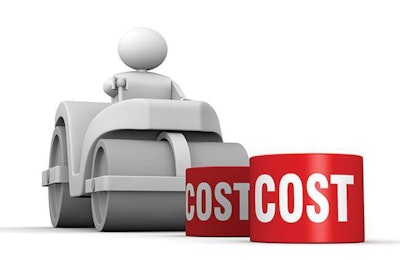Tracking costs is one part of cash flow management – the life blood of your company

Most contractors have no clue what their costs are, contends George Hedley, head of the Hardhat Presentations consulting firm. “They don’t know their overhead, their fixed costs, or what revenue they need to bring in to pay back their debts and make a profit. It’s hard to be successful when you don’t know your costs.”
And so it’s critical to find out exactly what your true costs are, advises Bob Biehl, director of construction industry services with the GBQ Partners accounting firm. “Contractors need to examine whether they really need a cost and that cost’s true impact on the business.”
Cash flow budgeting, projections
To get a handle on your true cash picture, Biehl advises, make it a habit to do cash flow budgeting and cash flow projections. These planning strategies will help you know where your cash surplus and shortfalls are during a period. If there’s a shortfall, you can figure out how to generate ways to cash. If there’s a surplus, perhaps you can pay down debt or buy equipment. “It helps you avoid surprises,” he says. And having a cash flow projection helps your credibility with your bank.
Look at your finances weekly, and then monthly, Hedley says. Have a monthly strategy session with key personnel to plot out your cash flow.
Evaluate your costs every year to make sure they are necessary to run the business, Biehl says. By doing a profit projection, you are forced to look at the make up of your overhead, line item by line item, and see what is necessary. “Cost control is as much about looking and evaluating as it is about cutting or adding costs,” he says. “This becomes general practice of running your business – whether in good or bad times.”
 Cost of doing business
Cost of doing business
Contractors have two basic types of costs: general business costs and job costs. Knowing what’s going on in both areas is essential to remaining profitable.
Labor is one of the primary costs that can get out of control, Biehl says. “Contractors tend to view their employees as their family, but they need to remember their business is the mother ship,” he says. “Even if they have to cut a percent of their labor, the rest of their people still have jobs and the business still survives.”
But there is a balance. One result of cutting labor, especially in recent years, is that you probably took on more work yourself. “I see a lot of owners who try to take on tasks themselves – such as accounting – to reduce costs,” Biehl says. But when he asks them what they do best, the answer is usually “field operations.” “I tell them to do what they need to be doing, and they’ll make more money than they’ll save doing these things themselves. Sometimes you do need to hire someone, or hire a consultant.”
Make receivables a priority, advises Hedley. Meet with your management team and make decisions on who is going to call each outstanding receivable.
Review past good times for lessons learned. When the phone is on constant ring and you’re putting in 16-hour days, cost control opportunities can slip by. “There was probably a lot of lost profit back in 2006,” Biehl says. “Contractors weren’t shopping around to make sure they were getting the best value.”
On the job
“Cost control is important because reality rarely matches what was estimated,” says Arnold S. Grundvig, author of “The 90-Minute MBA.” “If you don’t have cost controls in place, you have to wait until the job is over to see if you’ve made any money. Construction companies that do not use job costing are condemned to remain small or to fail.”
Cash flow projections will let you know where things stand, and if you have the capacity to take on more work. “I’m not a big proponent of reducing your gross margin on job,” Biehl says, “but at the same time, say it’s November and you’re a bit short on work and a job comes in that can be done in 30 days with little risk. You could tweak your gross profit for that one job. Projections will let you know if you can do this. It allows you to make decisions that ultimately will make the company more profitable.”
But watch margins as the economy starts to improve, Hedley says. You may have cut margins to the bone during the recession, and now need to reexamine what you charge after thoroughly looking at your true costs. “Contractors who make these kinds of cuts think they can save their way to success,” he says. “But the contractors who know their costs are the ones who make the money. The contractors who chase cheap work stay busy and stay broke.”
Too often, contractors view accounting as a backroom situation, becoming scorecard keepers three months after the fact, Biehl says. “The most successful contractors I work with are those who understand the relation between project management, estimating and accounting. They integrate and communicate between these functions. This means the accounting department is involved in job meetings, and is regularly giving the estimators labor rates and overhead percentages and direct general condition costs, making sure they have accurate information. It becomes part of your culture that there is regular communication between all those departments.”
Equipment is one job cost that needs a thorough evaluation, according to Hedley. “I encourage contractors to think like an investor. I know a $20 million civil contractor who owns no equipment. He’s leasing everything. He pays more in leasing, but saves on maintenance costs, insurance and bonding.”
Grundvig, who is also owner of accounting software firm A-Systems, is a natural proponent of job costing software, which accumulates actual costs into categories, allowing continuous comparison of actual versus estimated costs. “You can tell immediately where things are wrong,” he says.
“Have a tracking system in place to determine exactly how many man hours and equipment hours – by task – you have in a project,” Hedley agrees. While software programs sometimes have average rates built in, if you don’t track your own rates you won’t know if you’re making money. “You need a cost history library to refer back to for future bids. Once you’ve completed a job, review it to determine the actual rate per task,” he says.
“I believe that construction is one of the highest risk businesses in the United States, because so few builders do job costing,” Grundvig says.
Realize the impact of cost cutting
Grundvig uses this example: If you generate $1 in revenue by increasing sales, how much of it do you get to keep? Generating that dollar involved a lot of costs, including payroll, cost of goods sold and overhead allocations. Now generate that same dollar by reducing expenses. How much goes to the bottom line? All of it.
Of course, it’s not just a simple matter of cost cutting. There are legitimate costs that lead to increased revenue. It’s knowing what’s important, and what can be cut that’s key. “Growing revenues is necessary but not sufficient,” Grundvig says.
Cost control is a matter of informed decision making, Biehl stresses. “You need to know how a cost affects your business and what the impact will be if you cut, maintain or increase. For example, marketing is always easy to cut but it might be the thing that gets you the next job.”
Finally, realize getting a firm grip on your costs might require outside assistance. “Think of it like your first GPS system,” Hedley says. “You had to be trained. This is the same thing.”













